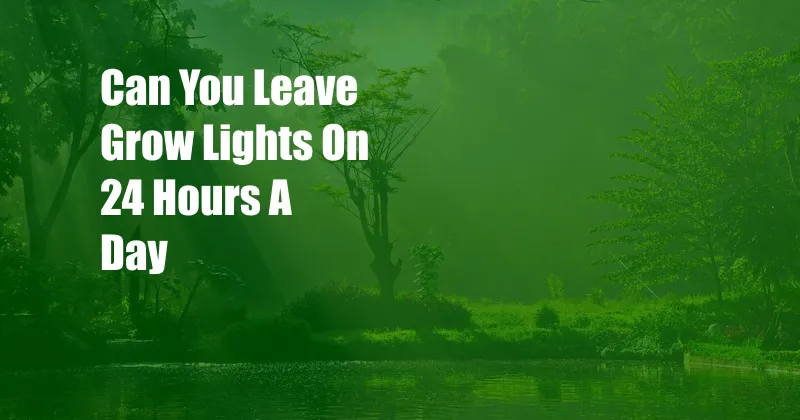
Can You Leave Grow Lights on 24 Hours a Day?
In the realm of indoor gardening, the question of whether to leave grow lights on for 24 hours a day has sparked extensive debate among horticulture enthusiasts. While some swear by the benefits of extended light exposure, others caution against its potential drawbacks. In this comprehensive guide, we delve into the intricate details of grow light usage and provide evidence-based insights to help you make informed decisions about your plants’ light regimen.
Before diving into the intricacies of lighting schedules, it’s essential to understand the fundamental role of light in plant growth. Light serves as the energy source for photosynthesis, the process through which plants convert carbon dioxide and water into glucose and oxygen. This process is essential for plant growth, development, and overall health.
How Many Hours of Light Do Plants Need?
The optimal amount of light for plants varies depending on the specific plant species, growth stage, and light intensity. However, as a general rule of thumb, most plants require 12 to 16 hours of light per day during the vegetative stage and 10 to 12 hours of light per day during the flowering stage. Providing more light than necessary does not necessarily accelerate growth or improve yields; in fact, it can lead to adverse effects.
The Effects of 24-Hour Lighting on Plants
The concept of leaving grow lights on for 24 hours a day stems from the assumption that more light equates to more growth. While this may hold true to some extent, extended light exposure can disrupt the plant’s natural circadian rhythm and lead to several problems:
- Exhaustion: Plants, like humans, require periods of darkness to rest and repair. Continuous light exposure can overstimulate plants, leading to exhaustion and reduced growth.
- Nutrient Depletion: During the dark period, plants undergo essential metabolic processes, such as nutrient uptake and transport. Uninterrupted light exposure can hinder these processes, resulting in nutrient deficiencies.
- Reduced Bud Production: For flowering plants, a period of darkness is necessary to trigger and maintain the flowering process. Continuous light exposure can disrupt this cycle, reducing bud production and overall yield.
Tips for Optimal Lighting Schedules
To maximize plant growth and health, it’s crucial to establish a consistent and appropriate lighting schedule:
- Vegetative Stage: Provide 12 to 16 hours of light per day during the vegetative stage, when plants are actively growing and developing foliage.
- Flowering Stage: Switch to a 10 to 12-hour light cycle during the flowering stage to promote bud production and increase yields.
- Dark Periods: Ensure plants receive a minimum of 6 hours of uninterrupted darkness each day to allow for rest and metabolic processes.
Expert Advice on Grow Light Schedules
Horticulture experts widely agree on the detrimental effects of 24-hour lighting on plants. Here’s what they have to say:
“Extended light exposure can lead to a buildup of reactive oxygen species (ROS), which can damage plant cells and tissues.” – Dr. Bruce Bugbee, Professor of Crop Physiology at Utah State University
“Plants have evolved to respond to changes in light and darkness. Disrupting their circadian rhythm can have negative consequences for their growth and development.” – Dr. Howard Resh, Plant Physiologist at Cornell University
Frequently Asked Questions
- Q: Can I leave my grow lights on for 24 hours a day if I use low-intensity lights?
A: No, low-intensity lights will not compensate for the negative effects of 24-hour lighting.
- Q: What happens if I accidentally leave my grow lights on for more than 24 hours?
A: While a few hours of extra light may not cause significant harm, prolonged periods of continuous light can have detrimental effects on plant health.
- Q: How can I tell if my plants are getting too much light?
A: Signs of excessive light exposure include leaf burn, stunted growth, and yellowing leaves.
Conclusion
To summarize, leaving grow lights on for 24 hours a day is generally not recommended for the optimal growth and health of plants. Providing a consistent and appropriate lighting schedule, with alternating periods of light and darkness, is crucial for maximizing plant development and productivity.
Are you interested in learning more about grow light schedules and other essential aspects of indoor gardening? If so, I encourage you to continue exploring our blog for a wealth of informative and practical resources. Together, let’s cultivate thriving and bountiful indoor gardens.